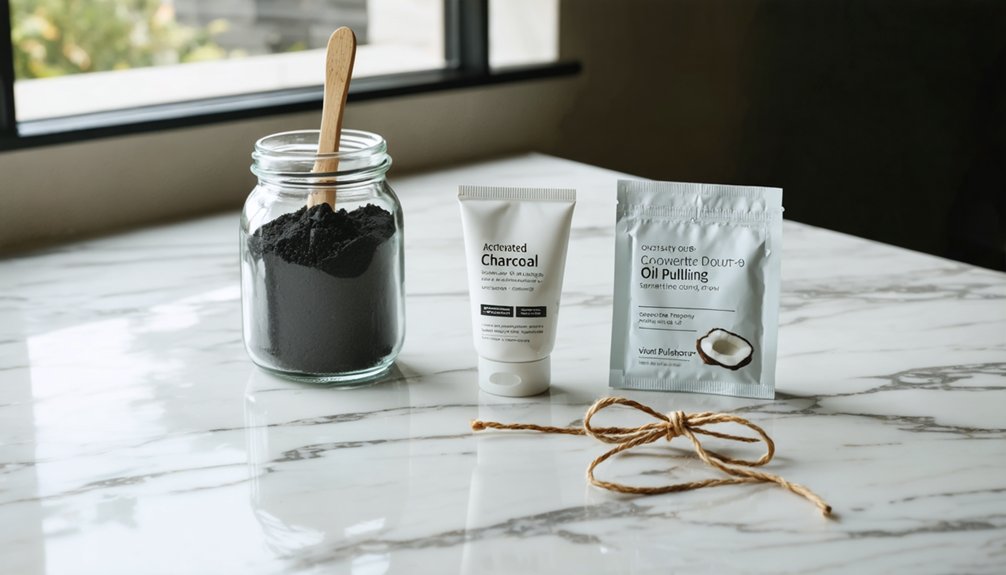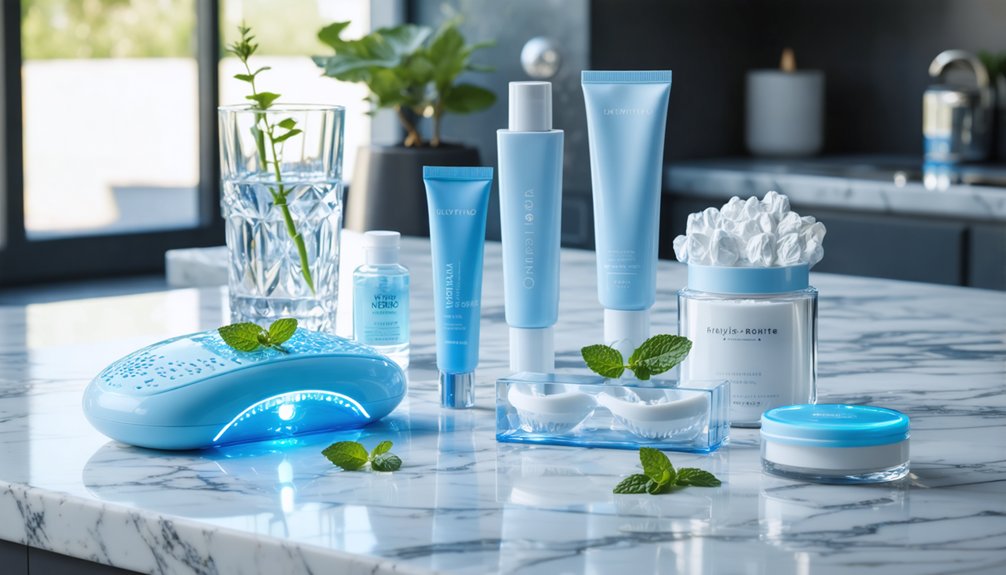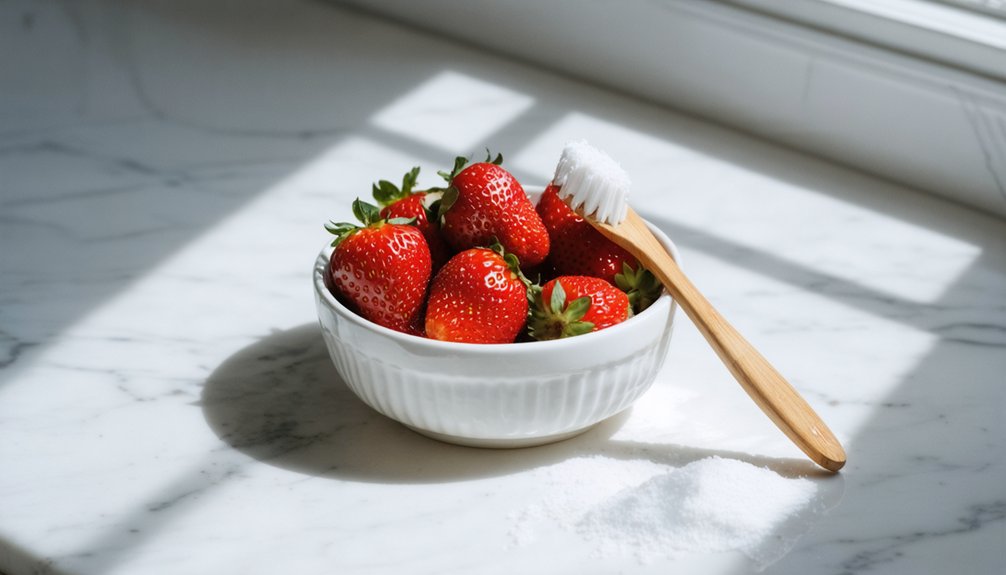You can achieve professional-level whitening results without painful sensitivity through three proven techniques. Professional treatments now include built-in desensitizing protection with specialized gels and temperature control. Custom-made trays offer precise application with adjustable wear times for maximum comfort. Peroxide-free solutions utilize gentle enzymes and natural compounds to break down stains while preserving enamel integrity. Understanding these options in detail will help you make an informed choice for your smile transformation.
Key Takeaways
- Professional whitening treatments with desensitizing protection offer customized pre-treatment plans and temperature-controlled applications for maximum comfort.
- Custom-fitted trays provide gentle whitening with adjustable wear times and precise gel application to minimize sensitivity.
- Peroxide-free alternatives like enzyme-based gels and natural methods offer effective stain removal without causing tooth sensitivity.
- Regular dental cleanings before whitening create optimal conditions and allow dentists to monitor sensitivity levels throughout treatment.
- Professional supervision ensures proper balance of whitening agents and desensitizing compounds while allowing adjustments based on individual needs.
Professional Whitening With Built-In Desensitizing Protection
While traditional teeth whitening can trigger discomfort, professional treatments now incorporate built-in desensitizing protection to guarantee a more comfortable experience.
Your dentist will start by evaluating your sensitivity levels and creating a customized pre-treatment plan using desensitizing gels and specialized toothpaste 1-2 weeks before whitening begins.
A professional teeth whitening journey begins with personalized sensitivity testing and preventive care to ensure optimal comfort during treatment.
Professional supervision assures you’ll receive the ideal balance of whitening agents and desensitizing compounds.
Your treatment will utilize lower-concentration formulas enhanced with potassium nitrate and fluoride, applied through custom-fitted trays for precise coverage.
Temperature control during application helps prevent nerve center irritation and enhances overall comfort.
Regular dental cleanings beforehand help create optimal conditions for whitening success by removing surface buildup that could interfere with results.
Your dentist will monitor your progress throughout each session, adjusting treatment times and concentrations based on your comfort level.
They’ll also apply protective fluoride varnishes between sessions to strengthen your enamel and maintain lasting sensitivity protection.
Custom-Made Trays: A Gentle Path to a Brighter Smile
For those with sensitive teeth, custom-made whitening trays offer a remarkably gentle yet effective path to teeth whitening.
These precisely molded trays deliver professional-grade results while minimizing discomfort through controlled gel application and superior fit. You’ll experience comfortable whitening with less gum irritation and sensitivity compared to generic alternatives. Most patients can achieve 1-2 shades lighter within just a few days of consistent use. Professional guidance comes included with every custom tray system to ensure optimal results.
Custom trays provide distinct advantages for sensitive teeth:
- Precise molding prevents gel leakage onto gums while ensuring even coverage of all tooth surfaces.
- Adjustable wear times (15-30 minutes daily) allow you to customize treatment based on sensitivity levels.
- Lower concentration gels can be used effectively due to the superior seal and contact with tooth surfaces.
These personalized trays enable gradual, consistent whitening while preserving enamel integrity – making them ideal for patients seeking gentler treatment options.
Peroxide-Free Solutions for Maximum Comfort
Beyond custom trays, peroxide-free whitening solutions offer exceptional comfort for individuals with tooth sensitivity.
You’ll find enzyme-based gels containing papain, bromelain, and ficin that effectively break down surface stains without damaging your enamel. These professional-grade formulations achieve results comparable to traditional bleaching methods while prioritizing your comfort.
Natural enzyme whitening through dietary choices can complement your efforts. Incorporate crunchy fruits and vegetables into your diet, and consider oil pulling with coconut oil for 15-20 minutes daily. Trained dental hygienists perform advanced whitening treatments that are especially gentle on sensitive teeth and gums. Dairy products provide natural whitening effects through their lactic acid content.
This ancient practice helps reduce plaque while gently lifting stains. For additional care, carefully applied activated charcoal or baking soda can safely remove surface discoloration when used sparingly.
These gentle alternatives protect your sensitive teeth while steadily improving their appearance.
Frequently Asked Questions
How Long Should I Wait Between Different Whitening Treatments?
You’ll need to wait 6-12 months between professional treatments, 2-4 weeks for at-home kits, and 1-2 weeks for natural methods. Follow whitening frequency guidelines and respect treatment recovery time.
Can I Use Whitening Products While Wearing Braces or Dental Appliances?
You’ll get better results waiting until after braces removal, as brackets impact whitening coverage. If needed during treatment, use specially designed products like Opalescence Go for safer, more even whitening.
Will Whitening Treatments Affect Existing Dental Work Like Crowns or Veneers?
Whitening treatments won’t change your crowns or veneers’ color since these dental materials aren’t porous. You’ll need to take into account that whitening effects on natural teeth may create shade mismatches with existing dental work.
Are There Specific Foods That Can Help Maintain Teeth Whiteness Naturally?
You’ll find natural whitening foods like strawberries, apples, and dairy products effective. Crunchy fruits for whitening work through mechanical cleaning, while enzymatic acids help remove surface stains and strengthen enamel.
Does Drinking Through a Straw Prevent Staining During the Whitening Process?
While straws can reduce staining by up to 50%, they’re not foolproof. You’ll get straw benefits by positioning it toward the back of your mouth, but tongue contact still transfers staining compounds.
References
- https://deefordentist.com/whitening-methods-for-sensitive-teeth/
- https://egglestondentalcare.com/best-teeth-whitening-for-sensitive-teeth/
- https://buforddentist.com/what-are-the-best-whitening-options-for-sensitive-teeth/
- https://pmc.ncbi.nlm.nih.gov/articles/PMC10873745/
- https://www.clearwavedental.com/comparing-different-teeth-whitening-methods
- https://www.parkcreekdentalcare.com/blog/teeth-whitening-for-sensitive-teeth-safe-options-that-work/
- https://pmc.ncbi.nlm.nih.gov/articles/PMC4058574/
- https://truesmileworks.com/which-teeth-whitening-method-is-best-for-sensitive-teeth/
- https://www.stadiumfamilydentistryannarbor.com/teeth-whitening-tips-and-tricks-for-sensitive-teeth/
- https://www.drtoddsmileon.com/professional-whitening-for-sensitive-teeth-special-approaches-for-comfort/



